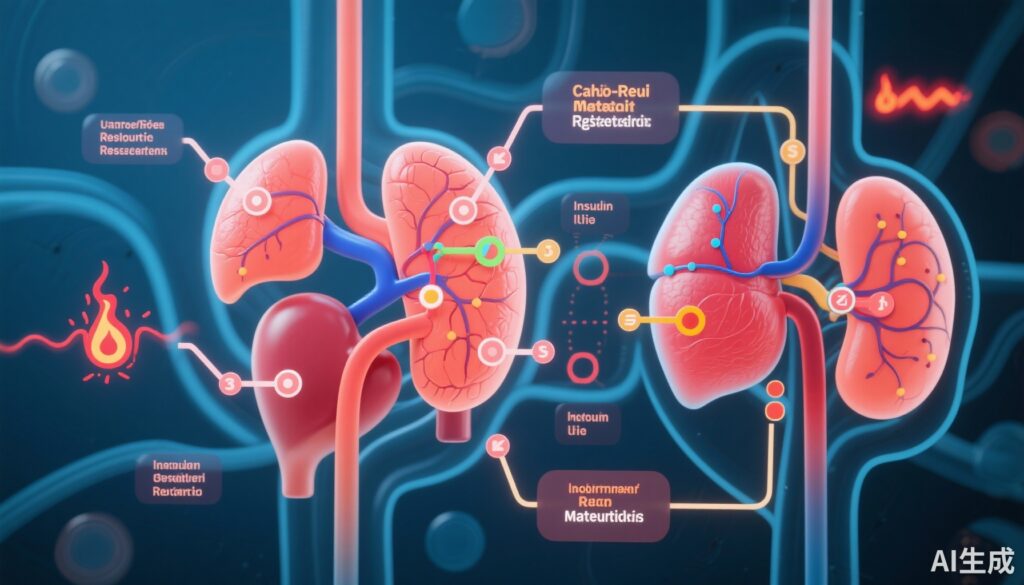Highlight
This prospective study of over 327,000 UK Biobank participants establishes significant associations between six insulin resistance (IR)-related indices and both the onset and progression of cardio-renal-metabolic (CRM) multimorbidity. Particularly, indices involving waist circumference and waist-to-height ratio (TyG-WC and TyG-WHtR) alongside METS-IR showed the strongest predictive capability. Mediation analysis implicated systemic inflammation and kidney dysfunction as partial biological pathways linking IR indices to CRM disease development.
Study Background
Cardio-renal-metabolic multimorbidity encompasses the co-occurrence of cardiovascular disease, chronic kidney disease, and metabolic disorders such as type 2 diabetes mellitus. These conditions collectively pose a substantial health burden worldwide due to their high prevalence, complexity, and compounded risk of adverse outcomes.
Insulin resistance (IR) is a pathophysiological hallmark underlying metabolic dysfunction, and is increasingly recognized as a shared mechanistic driver of CRM diseases. Established clinical indices that estimate IR from routine laboratory and anthropometric measurements—such as the triglyceride-glucose (TyG) index and its variants incorporating body mass or waist metrics—offer practical tools for risk stratification.
However, prior research has largely examined these indices in relation to isolated disease outcomes or cross-sectional data, limiting insights into their utility for anticipating multimorbidity progression in a dynamic, longitudinal context.
Study Design
Leveraging data from the UK Biobank prospective cohort, this study included 327,692 participants free from CRM disease at baseline. Participants were followed for a mean of 13.6 years for development of first, second, and third CRM conditions.
Six validated IR-related indices were calculated using standard formulas: TyG index, TyG-body mass index (TyG-BMI), TyG-waist circumference (TyG-WC), TyG-waist-to-height ratio (TyG-WHtR), triglyceride/high-density lipoprotein cholesterol (TG/HDL-C) ratio, and metabolic score for insulin resistance (METS-IR).
Statistical analyses applied Cox proportional hazards models and advanced multistate models to assess the associations between IR indices and the risk of CRM disease onset and progression. The predictive performance of each index was evaluated by area under the curve (AUC), net reclassification improvement (NRI), and integrated discrimination improvement (IDI). To explore potential biological mechanisms, mediation analyses examined the roles of inflammatory, hepatic, and renal biomarkers.
Key Findings
Over follow-up, 17.3% of participants developed at least one CRM disease. All six IR indices showed significant associations with increased risk of incident CRM multimorbidity and disease progression.
Notably, TyG-WC, TyG-WHtR, and METS-IR demonstrated superior predictive performance for CRM incidence. For instance, each 1-standard deviation (SD) increase in TyG-WC elevated the risk of developing first, double, and triple CRM diseases by 51.4%, 88.6%, and 128.7%, respectively (all P < 0.001). Similar risk gradients were observed for TyG-WHtR and METS-IR.
Multistate Cox models confirmed consistent and graded associations: a 1-SD increase in TyG-WHtR was linked with a 65.3% higher risk of transitioning from a healthy state to first CRM disease, 34.6% from first to double CRM diseases, and 26.7% from double to triple CRM multimorbidity (all P < 0.001).
Predictive performance metrics underscored the added value of TyG-WC, TyG-WHtR, and METS-IR, with the highest AUC, NRI, and IDI values across endpoints, indicating better discrimination and risk reclassification over traditional models.
Mediation analysis revealed that systemic inflammation markers, hepatic function indicators, and importantly kidney function partially mediated the relationship between IR indices and CRM multimorbidity development, supporting biological plausibility.
Expert Commentary
This comprehensive analysis illustrates that simple, non-invasive IR-related indices can effectively stratify risk for cardio-renal-metabolic disease onset and progression in a large general population cohort. The incorporation of central adiposity dimensions (waist circumference, waist-to-height ratio) with metabolic parameters likely captures critical elements of visceral adiposity and metabolic derangement driving CRM pathology.
The use of multistate modeling provides nuanced understanding of disease trajectories beyond binary outcomes, which is highly relevant for clinical risk management and early intervention prioritization.
While these findings add substantial evidence to the prognostic utility of IR-related indices, limitations include observational design, potential residual confounding, and the need for external validation in diverse populations. Furthermore, it will be important to explore how these indices perform when integrated with other established risk factors and biomarkers in clinical decision-making.
Conclusion
IR-related indices, especially TyG-WC, TyG-WHtR, and METS-IR, hold promise as accessible predictors of cardio-renal-metabolic multimorbidity risk and progression. Their application could enhance early identification of high-risk individuals for targeted prevention strategies.
The mediation findings highlight the intertwined roles of inflammation and kidney function pathways, which may represent therapeutic targets.
Future prospective studies and clinical trials are warranted to confirm these findings’ applicability and to establish clinical workflows incorporating these markers for improved management of cardio-renal-metabolic health.
Funding and Trial Registration
The original research was supported by the UK Biobank resource. No clinical trial registration is applicable given the observational cohort study design.
References
Liu L, Yu G, Ji X, Wang Y, He H. Associations of six insulin resistance-related indices with the risk and progression of cardio-renal-metabolic multimorbidity: evidence from the UK biobank. Cardiovasc Diabetol. 2025 Sep 30;24(1):377. doi: 10.1186/s12933-025-02928-w. PMID: 41029369; PMCID: PMC12487372.


